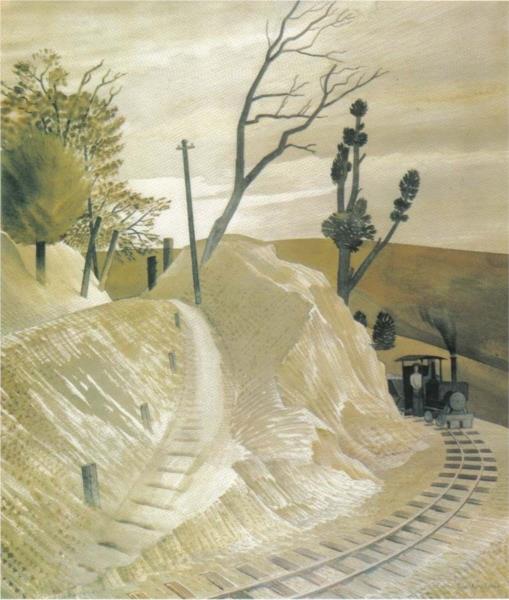Description
Eric Ravilous, a distinguished name in the British artistic panorama of the twentieth century, gives us a visual jewel in his work "Steam train bending a curve" (Steam Train Rounding to Bles), made in 1935. This painting encapsulates the essence of the landscape Rural English, presented through the inquisitive and nostalgic gaze of the author, who feeds our perception with a mixture of realism and a subtle tendency towards the dreamlike.
The composition of the work is a testimony of Ravilius' ability to imbue dynamism and calm in the same scene. The train, central element and undoubtedly an icon of an even latent era painting with an elegance that challenges its weight and volume. The arrangement of the roads, which are gently curved by the wavy landscape, directs the viewer's gaze towards the horizon, creating a diagonal that gives depth and movement. This subtle dynamism is a tool that Ravilious uses with a mastery to capture our attention and guide us through painting.
The use of color in this work is equally remarkable. The predominantly soft and turned off tones, with a palette of mossy green, brown earth and clear gray, combine with the black and white banks of the train and their trail of smoke to form a harmonious and delicate set. These colors faithfully reflect the atmosphere of the English field and, at the same time, they tell us about a sense of nostalgia and calm, a sensation reinforced by the gray sky that threatens rain, but that is not oppressive, but rather comforting.
In "steam train bending a curve", we do not find visible human figures, which enhances the sensation of a slightly idealized nature, barely touched by the hand of man beyond the traces of human engineering such as the tracks and the train itself. This absence of characters allows the viewer to project on the scene, almost feel the rhythmic sound of the train and the smell of steam mixed with the fresh grass of the field.
Ravilus also seems to be paying tribute to the union between the natural and the artificial, a recurring theme in his work. The steam engine, symbol of progress and modernity, contrasts but does not collide with the serenity and timelessness of the landscape. This juxtaposition occurs harmoniously, evoking a peaceful and complementary coexistence that was eloquent in England of the early twentieth century.
The Ravilious technique is characterized by its precision and meticulous attention to detail, which is evident in the representation of train and landscape elements. Each tree, each trace of smoke, every rail is painted with a thorough care that speaks of its formation as a recorder and its deep respect for direct observation. This detailed realism is not exempt from a certain visual poetics, where reality is intertwined with almost dream elements.
As part of the circle of artists who gravitated around the firm Curwen Press, Ravilus moved in an environment of continuous innovation and graphic experimentation, things that certainly influenced their methodology and its aesthetic finish. Their contemporaries in this group also explored the potential of clean lines and balanced compositions, and in Ravilus, these influences crystallize in a unique way.
"Steam train bending a curve" is not only a window to the past, but also a bridge between the old and the modern, between the natural and the manufactured. Through this work, Eric Ravilus invites us to a serene and leisurely contemplation of the landscape, reminding us of the intrinsic beauty of small things and the harmony that can be found in the most unexpected places.
KUADROS ©, a famous paint on your wall.
Hand-made oil painting reproductions, with the quality of professional artists and the distinctive seal of KUADROS ©.
Art reproduction service with satisfaction guarantee. If you are not completely satisfied with the replica of your painting, we refund your money 100%.

